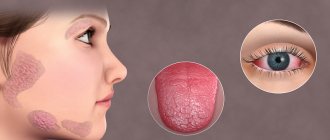There is an opinion that visual impairment is inherited. This is confirmed by children with poor vision who suffer from the same diseases as their parents. But does the cause of such problems really lie only in heredity, or are there other prerequisites for the deterioration of a child’s visibility?
It is not entirely correct to talk about the possibility of inheriting poor vision, as ophthalmologists say. A predisposition to myopia, farsightedness or another disorder can be passed on to a child, but not the disease itself. According to statistics, this does not happen very often: only 3% of all newborns have a hereditary predisposition to poor visibility in the future.
The risk of developing myopia and other vision defects is highest in those children whose both parents suffer from similar eye disorders. When only one person has such a disease, the likelihood of its manifestation in the baby is reduced by 30%. But if, for example, parents have acquired rather than congenital myopia, it cannot be genetically passed on to their child.
Causes of hereditary myopia
In this article
- Causes of hereditary myopia
- Diagnosis of hereditary myopia in children
- Hereditary myopia: provoking factors
- Hereditary myopia and related diagnoses
- Treatment methods for hereditary myopia
- Are orthokeratology lenses effective for hereditary myopia?
- Laser surgery for hereditary myopia - features
- Disease prevention
Myopia can indeed be inherited from one or both parents. It is worth noting the fundamental difference between hereditary and congenital myopia. Congenital pathology manifests itself immediately after the birth of a child, while the development of hereditary myopia can be avoided. The fact is that a person does not inherit the disease itself, but a predisposition to it, so if you take the necessary measures, you can reduce the likelihood of developing the disorder several times. Hereditary myopia - causes:
- gene mutations that reduce collagen synthesis, causing the sclera to become soft;
- a weak sclera cannot maintain the shape of the eye, it takes on an oval shape, which contributes to the formation of myopic focus;
- special shape of the eyeball;
- morphologically defective ciliary muscle, which leads to weakness of accommodation.
Is this myopia curable? Hereditary myopia develops gradually, but a predisposition to it can be detected at an early stage. The earlier the tendency to myopia is identified, the better, because a number of effective measures can be taken that will help avoid the appearance of serious refractive errors and prevent the progression of the disease.
The essence of genetics
As the well-known Koroviev said in Bulgakov’s famous novel “The Master and Margarita”: “Issues of blood are the most difficult in the world! I won’t be at all wrong if, speaking about this, I mention a fancifully shuffled deck of cards...”
After so much time, scientists come to the conclusion that 100% of all pathologies are encoded in our genes.
Each of us has our own genotype, which is passed on from our parents. Each phenotypic manifestation: eye color, hair color, nose shape, lips, face shape, and even the structure of the eyeball is encoded by two genes. One is transmitted by mom, the second by dad. The combination of these genes determines how the trait will manifest itself in the little person: which parent he will resemble.
Every person's genotype is encoded in their chromosomes. There are 23 pairs of them in the body: 22 pairs of so-called somatic chromosomes, and the 23rd pair determines a person’s gender.
Chromosomes encode genes, when deciphered, one can speak with 100% confidence about a person’s predisposition to a particular pathology. Susceptibility to the development of eye diseases, including myopia, is also determined by genes.
It is not necessary that a child be born with myopia. It can manifest itself in the process of growth and development. It may not appear at all in a child whose parents both wear distance glasses. Why does this happen?
There are several types of genes: dominant and recessive. Dominant - overwhelming and main, if it is embedded in the code, then it will always manifest itself - it is denoted by a capital Latin letter. A recessive trait will only appear if it finds the same pair for itself, so it is denoted by a small letter.
The trait can also be linked to the sex chromosome. The sex chromosomes of women are XX, and those of men are XY, so if the trait is linked to the Y chromosome, then it will appear in 100% of boys, if with X, it is dominant and is in the dad’s genotype, then all boys will be healthy, but girls will be lucky less, since they will all be sick.
Diagnosis of hereditary myopia in children
Normally, children under 5-6 years of age are farsighted, hypermetropia can reach 2-3 diopters. At the age of 6-7 years, vision stabilizes. If, during an examination of, for example, a two-year-old child, a zero reserve of farsightedness is discovered, then with a high degree of probability we can talk about a predisposition to myopia. Ophthalmologists classify such children as a risk group and prescribe them treatment using devices, simulators, etc. Childhood myopia can be successfully corrected and the disease can be prevented from fully manifesting itself. Diagnosis of hereditary myopia in children:
- determination of visual acuity using a table with images of objects familiar to the child: cars, Christmas trees, stars, etc.;
- measuring refraction using an autorefractometer;
- measuring the length of the eyeball, checking binocular functions;
- examination of the fundus with a narrow and dilated pupil.
You should not rely only on the results of a vision test according to the table, because the child may also have hidden myopia. The most optimal diagnostic method is considered to be studies whose results do not depend on the child’s correct performance of any actions, that is, this is a computer examination using modern equipment.
How to recognize if a child has vision problems
Preventive examinations should be regular. But parents also need to be more careful. Take your child to an ophthalmologist if:
to examine any object, the child turns his head, tilts it to one side, raising his shoulder;
the child blinks frequently and squints;
his hand-eye coordination is impaired: for example, the child often hits standing objects, drops things on the floor;
Parents with the best intentions force the early development of their children, and then are surprised that eye problems begin
holds a book or other object too close to the eyes, rubs them, runs a finger along the line while reading, gets tired quickly; these signs may indicate farsightedness;
complains of headaches, eye fatigue, and with visual stress he is bothered by nausea, dizziness, and motion sickness.
Many problems can be solved if treatment is started on time. It is often even possible to save a child from constantly wearing glasses. For example, a course of treatment for farsightedness in children may consist of five or six different methods, including hardware procedures to stimulate vision. True, both parents and the child will have to be patient: such “cycles” of treatment are carried out 3-4 times a year to consolidate the result.
And at 9-10 years old, laser correction will help relieve the child of farsightedness and astigmatism.
Hereditary myopia: provoking factors
If one or both of the child’s parents are myopic, it is necessary to avoid the negative influence of certain factors on the development of the optical system of the baby’s eyes. It is extremely important to pay attention to the prevention of the disease and apply a set of measures, including hardening, physical activity, good nutrition, enriched with foods high in vitamins that are good for the eyes. What can trigger the development of myopia:
- unbalanced diet, lack of vitamins and beneficial microelements;
- high visual load: games on a tablet, computer, uncontrolled watching of TV shows, etc.;
- weak motor activity - during movement, a person’s blood is enriched with oxygen, which improves metabolism and promotes normal growth of the eyeball;
- frequent colds, chronic diseases, reduced immunity.
Weakness of connective tissues is a common cause of myopia in children and progression of the disease in adolescents. To avoid deformation of the sclera, you should balance your diet, enrich it with vitamins A, B, C, as well as zinc, magnesium, iron (they are necessary to strengthen connective tissues).
Bangs covering one eye impair vision
To fully perceive the volume and depth of space, we always need both eyes. If one of them is constantly covered by hair, it does not participate in the vision process and stops working. Visual acuity in this eye decreases and obscuration or deprivation amblyopia develops.
This warning primarily concerns parents of young children. Their visual system is still developing; babies may not understand that hair interferes with their vision.
Specifically
Hereditary myopia and related diagnoses
Early diagnosis of hereditary myopia allows timely detection of ophthalmological disorders accompanying myopia that require surgical treatment. So, myopia is often accompanied by:
- astigmatism;
- refractive amblyopia;
- squint;
- dystrophic changes in the retina.
The sooner measures are taken to correct astigmatism, the less likely it is to develop various complications, since constant visual strain leads to deterioration of vision. And if treatment for amblyopia is not started in a timely manner, then over time the suppression of visual functions in the amblyopic eye may increase.
Treatment methods for hereditary myopia
The first signs of visual impairment due to hereditary myopia can appear both in early childhood and adolescence. Usually the changes are associated with a decrease in the body's protective functions, stress, and visual stress. Hereditary myopia is a predisposition to a disease that can manifest itself under certain conditions. This type of myopia is successfully corrected with glasses and contact lenses, and in childhood and adolescence it is treated using hardware techniques. How can you cure myopia? Treatment of hereditary myopia:
- vacuum massage - improves blood circulation, eye hydrodynamics and ciliary muscle function;
- infrared laser - relieves spasm of accommodation, improves nutrition of eye tissue;
- electrical stimulation - increasing the conductivity of impulses in the optic nerve;
- exercises to train accommodation, improve blood supply and metabolism in the organs of vision.
How can teenage myopia be cured? Loss of vision in adolescence is not always associated with the development of true myopia. Often, children 10-12 years old see worse due to a spasm of accommodation. In addition to true myopia, they also develop false, accommodative myopia, which can be eliminated by doing a set of exercises, putting drops into the eyes that relax the ciliary muscle, and taking vitamins that are good for the eyes. In adolescents with true myopia, with a spasm of accommodation, vision can fall by 3 diopters, and if the spasm is eliminated, the vision will improve accordingly. Since laser correction is not recommended until the age of 18, vision is corrected with glasses or contact lenses. There is also a separate type of lenses - orthokeratological ones, which are made of hard polymer and affect the shape of the cornea, changing its profile.
Are orthokeratology lenses effective for hereditary myopia?
Orthokeratological lenses are widely in demand by people with myopia, who for some reason cannot undergo laser surgery or get used to glasses or contact lenses. Such lenses are also called night lenses, since they act on the cornea throughout the night, and in the morning they must be removed. Then you can go the whole day without correction with glasses. Features of orthokeratology lenses:
- indicated for myopia up to -6 diopters;
- are made to order taking into account existing disorders in the optical system of the eye;
- getting used to lenses of this type takes a long time, since they are hard and at first cause a number of unpleasant symptoms;
- the result of the correction is high visual acuity, achieved after a few days of using orthokeratological lenses;
- To get the full effect, you need to stay in the lenses for at least 9-10 hours.
Myopia cannot be completely cured by orthokeratological lenses, but they significantly improve a person’s quality of life, although they require daily cleaning and storage in a special solution. The advantages of this method of correcting hereditary myopia are reversibility. The cornea restores its previous shape and for this it is enough not to use lenses for some time.
Diseases transmitted through the male line
In ancient times, children who had various developmental disabilities were constantly mocked and ridiculed. In addition, people did not understand for what reasons such a child could be born. Only modern medicine has provided an explanation for the origin of many diseases, although, unfortunately, they have not yet learned how to treat them.
Diseases transmitted through the male line are just as difficult to treat as other hereditary disorders.
Doctors can only warn about abnormal fetal development and suggest making difficult choices.
Laser surgery for hereditary myopia - features
Hereditary myopia, if it has already manifested itself, is incurable, and high visual acuity can only be restored with the help of laser surgery (correction of the corneal profile or implantation of a phakic lens). It is important that before surgery, myopia has not progressed for a couple of years and that this has been documented. Depending on the characteristics of the pathology, specialists may offer several correction options. Nowadays, SMILE and FemtoLASIK are considered the most optimal methods of laser correction (if the thickness of the cornea allows), since this intervention does not affect the upper layers of the cornea with many nerve endings, so healing occurs quickly. The essence of laser correction:
- During surgery, the laser creates the surface of the cornea with the required optical characteristics - thus correcting the refraction of light;
- visual acuity after surgery allows you to do without glasses and contact lenses - it is assumed that vision after surgery will be the same as it was with the maximum possible correction with glasses;
- The accuracy of the laser is the highest, all processes are controlled by computer programs, sensors, etc. — for example, the sensor continuously monitors the temperature of the cornea, this prevents its overheating;
- healing occurs quickly, there is no need to wear a special protective lens, since the operation is not traumatic, visual acuity is restored within a few hours.
If the patient has high myopia and laser techniques are not effective, he may be offered phakic lens implantation. The choice of such lenses that correct myopia, astigmatism, and presbyopia is quite large. Manufacturers are constantly bringing to market improved models of lenses with additional properties, for example, in the form of protection against blue radiation.
Disease prevention
To prevent myopia from developing, even with a clear predisposition to pathology, or from progressing if the disease does manifest itself, it is necessary to carry out a set of useful preventive measures. First of all, physical activity is necessary, this is important for both children and adults. Regular walking in the fresh air reduces the risk of developing myopia by twenty-five percent. What else can you do to avoid myopia or prevent it from progressing:
- a balanced diet enriched with healthy foods high in vitamins A, E, C, as well as lutein - a substance necessary to protect the retina from negative effects;
- doing eye exercises every day;
- compliance with sleep, rest, work and visual stress;
- proper organization of the workspace (local lighting, ergonomic furniture, etc.).
Often vision deteriorates due to a spasm of accommodation. It should be remembered that if myopia is diagnosed, correction is important to avoid eye strain, so you should not give up wearing glasses. The genes for hereditary diseases, such as myopia, are very strong, but still, if you take protective measures in a timely manner and carry out all the necessary preventive measures, you can reduce the likelihood of developing pathology.
How is myopia inherited?
Remember that the disease progresses only if the first signs are not eliminated and myopia treatment is ignored. How is myopia transmitted? The RASGRF1 gene, located on chromosome 15, is responsible for the transmission of myopia.
Every person has it, but its variations vary. It can be transmitted through both the female and male lines. In addition to myopia, astigmatism is also inherited - in 50 percent of cases.











